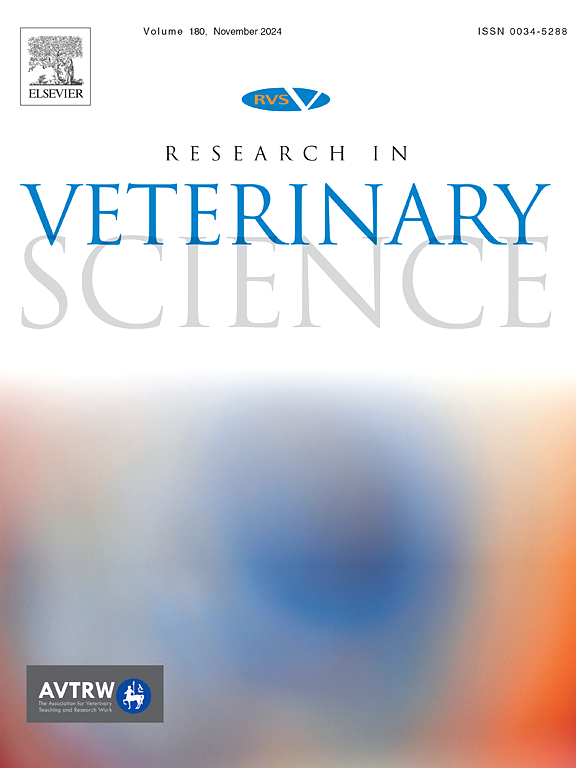Variations in the tear film lipid layer by age in healthy brachycephalic dogs
IF 2.2
3区 农林科学
Q1 VETERINARY SCIENCES
引用次数: 0
Abstract
This cross-sectional study evaluates the morphological and qualitative changes in the meibomian glands (MGs) and tear film lipid layer (TFLL) associated with aging and sex in canine brachycephalic breeds. One hundred and eleven brachycephalic dogs with normal eyes were included. Dogs were divided into three age groups: ≤4 years (G1), >4 and < 10 years (G2) and ≥ 10 years (G3). Schirmer test I (STT I), upper eyelid MGs noncontact infrared meibography (NIM), tear interferometry (TFI) and tear film breakup time (TFBUT) were performed in each eye. Loss of MGs and lid margin abnormalities (LMAs), as well as TFI patterns were scored from 0 to 3 depending on severity. Normality was assessed with the Shapiro-Wilk test. The Kruskal-Wallis test was used for the analysis of variance among groups. Pearson's or Spearman's correlation coefficient was used to assess the correlation between MG loss and STT I values. Significance was set at p < 0.05. Forty-four Shih-Tzus, 37 Pugs and 30 French Bulldogs were enrolled in the study. Median age was 39.5 months (range 30–48 months) in G1, 94.5 months (range 65–118 months) in G2, 154.5 months (range 120–201 months) in G3. Loss of MGs was statistically higher in G2 and G3 (p < 0.001) and was associated with a reduction in TFI scores (p < 0.001) and STT I (p < 0.001). Loss of MGs was then negatively correlated with TFBUT. No statistical differences were associated with sex (p > 0.05) or breed (p > 0.05). The tear film lipid layer appears to be negatively affected by age in brachycephalic dogs.
健康短头犬泪膜脂质层随年龄的变化
本横断面研究评估了短头犬品种睑板腺(mg)和泪膜脂质层(TFLL)与年龄和性别相关的形态学和质变。包括111只眼睛正常的短头犬。将犬分为3个年龄组:≤4岁(G1)、>;4和<;10年(G2)和≥10年(G3)。每只眼进行Schirmer试验I (STT I)、上眼睑mg非接触红外计数仪(NIM)、泪液干涉仪(TFI)和泪膜破裂时间(TFBUT)检测。mg丢失和眼睑边缘异常(LMAs)以及TFI模式根据严重程度从0到3分。用夏皮罗-威尔克试验评估正常性。组间方差分析采用Kruskal-Wallis检验。使用Pearson’s或Spearman’s相关系数评估MG损失与STT I值之间的相关性。p <为显著性;0.05. 44只西施犬、37只巴哥犬和30只法国斗牛犬参加了这项研究。G1组中位年龄39.5个月(范围30-48个月),G2组94.5个月(范围65-118个月),G3组154.5个月(范围120-201个月)。G2组和G3组mg的损失在统计学上更高(p <;0.001),并与TFI评分降低相关(p <;0.001)和STT I (p <;0.001)。mg的损失与TFBUT呈负相关。性别差异无统计学意义(p >;0.05)或品种(p >;0.05)。在短头畸形犬中,泪膜脂质层似乎受到年龄的负面影响。
本文章由计算机程序翻译,如有差异,请以英文原文为准。
求助全文
约1分钟内获得全文
求助全文
来源期刊

Research in veterinary science
农林科学-兽医学
CiteScore
4.40
自引率
4.20%
发文量
312
审稿时长
75 days
期刊介绍:
Research in Veterinary Science is an International multi-disciplinary journal publishing original articles, reviews and short communications of a high scientific and ethical standard in all aspects of veterinary and biomedical research.
The primary aim of the journal is to inform veterinary and biomedical scientists of significant advances in veterinary and related research through prompt publication and dissemination. Secondly, the journal aims to provide a general multi-disciplinary forum for discussion and debate of news and issues concerning veterinary science. Thirdly, to promote the dissemination of knowledge to a broader range of professions, globally.
High quality papers on all species of animals are considered, particularly those considered to be of high scientific importance and originality, and with interdisciplinary interest. The journal encourages papers providing results that have clear implications for understanding disease pathogenesis and for the development of control measures or treatments, as well as those dealing with a comparative biomedical approach, which represents a substantial improvement to animal and human health.
Studies without a robust scientific hypothesis or that are preliminary, or of weak originality, as well as negative results, are not appropriate for the journal. Furthermore, observational approaches, case studies or field reports lacking an advancement in general knowledge do not fall within the scope of the journal.
 求助内容:
求助内容: 应助结果提醒方式:
应助结果提醒方式:


